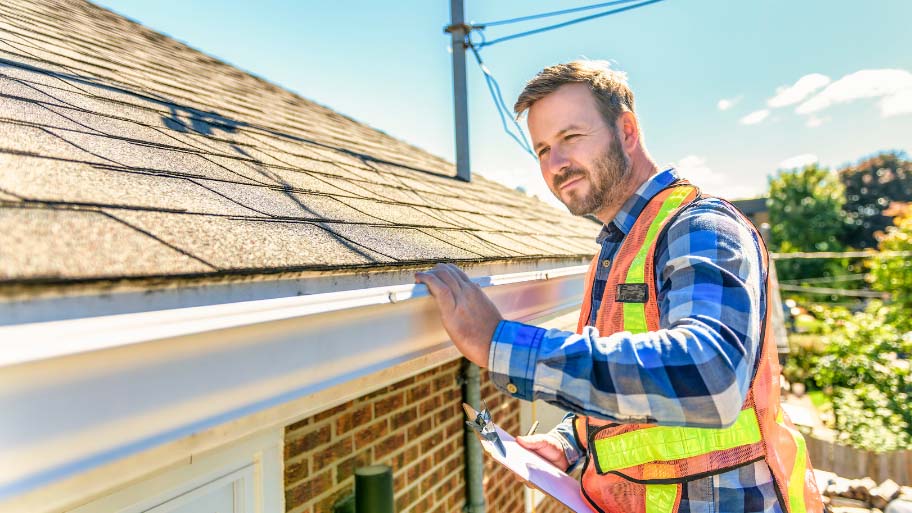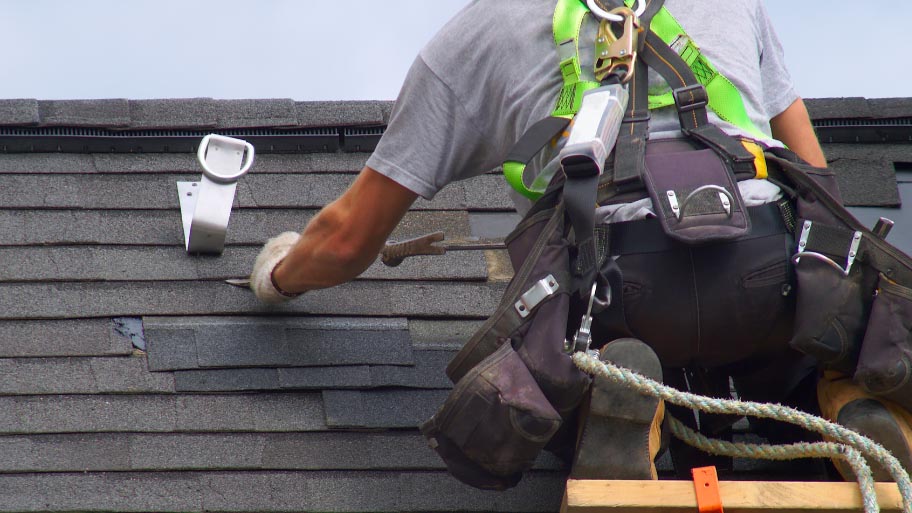Your roof is more than a weather barrier; it’s key to your home’s safety. Exploring why regular roof inspections are crucial can reveal how they play a pivotal role in maintaining the integrity and safety of your home. Overlooking this can lead to costly repairs and health risks for your family.

As cited by This Old House, investing in a new metal roof could set you back anywhere from $5,000 to $20,000, while an asphalt shingle roof might cost you between $7,000 and $12,000. These aren’t small sums, and regular inspections are your best bet to safeguard this investment.
Failing to keep up with these checks could result in more serious problems down the line, forcing you to replace your roof earlier than you’d like.
By neglecting regular roof inspections, you’re not just risking the integrity of your home but also setting yourself up for unexpected financial burdens.
Maintaining the condition of your roof goes beyond just keeping water out; it’s an integral part of safeguarding your home and everyone in it. A roof in good shape offers robust defense against environmental factors like precipitation, gusty winds, and even snowfall.
Additionally, a well-kept roof is key to optimizing your home’s energy use, as it helps maintain indoor temperatures and lowers utility bills. Furthermore, a sound roof can inhibit the development of health hazards like mold and mildew, ensuring a healthier living space for you and your loved ones.
Being vigilant about roof check-ups can have a ripple effect on your finances.
Early detection of minor flaws can prevent you from facing exorbitant repair costs or the financial burden of a complete roof overhaul. This is why regular roof inspections are crucial; they can significantly reduce the financial burden of unexpected repairs.
Plus, a roof in tip-top shape can be a strong selling point, potentially boosting your home’s market value.
Industry professionals suggest that a well-cared-for roof could even add a noteworthy percentage to your home’s resale value.
Many homeowners are unaware that the condition of their roof can significantly impact their home insurance rates. Insurance companies often assess the state of your roof when determining your premium.
A well-maintained roof can lead to lower insurance costs, while a neglected roof can result in higher premiums or even policy cancellation. This is because a well-kept roof is less likely to result in claims for water damage, structural issues, or other related problems.
According to Fixr, well-maintained asphalt shingle roofs have a lifespan of up to 20 years. In contrast, neglecting regular inspections and maintenance could necessitate a replacement much sooner. As for metal roofs, State Farm notes that with proper care, they can last between 40 to 70 years, a significant increase compared to poorly maintained ones.
When you book a roof inspection, know that it’s a thorough process, far from a mere surface-level review of your shingles. Inspectors adhere to a detailed checklist that covers multiple facets of your roof’s condition. They’ll thoroughly scrutinize the following:
Additionally, they’ll be on the lookout for any indicators of moisture accumulation, decay, or metal corrosion. Overlooking any of these components could compromise your roof’s structural integrity and result in costly repairs later.
Special attention is given to areas prone to leaks and water damage, such as valleys, joints where different roof planes meet, and the areas around features like chimneys and skylights. These are the hotspots where problems are most likely to occur, and a meticulous inspection of these areas can prevent potential disasters.
Understanding the inspection process can help homeowners prepare for it. Typically, the inspector will start by examining the roof from the ground level, using binoculars for a closer look at higher points. They may then climb onto the roof for a more detailed inspection, taking photos for documentation. This step-by-step approach ensures that no stone is left unturned.
Anticipate that the inspector will be meticulous, as a detailed evaluation is key to identifying any potential issues. Specialized tools such as moisture-detecting devices may be employed to uncover hidden problems.
Additionally, the inspector is likely to venture into the attic to assess the quality of insulation and ventilation, factors that can also influence how long your roof will last.
On average, a roof inspection can take between 45 minutes to 2 hours, depending on the size and complexity of the roof. Common issues often found during inspections include missing or damaged shingles, clogged gutters, and issues with flashing. Being aware of these statistics can help you set realistic expectations and plan your day accordingly.

Overlooking your roof’s maintenance might appear to be a cost-saving strategy at first glance, but it’s a financial pitfall in disguise. By forgoing routine check-ups, you’re inadvertently inviting bigger, more expensive troubles.
What starts as a trivial issue, like a single dislodged shingle or a slight leak, can quickly snowball into a major ordeal that demands extensive repairs or even necessitates a full roof overhaul.
In the short term, dodging an inspection fee—typically between $100 to $500—may seem like a win. However, this short-term saving can be deceptive. Ignored minor issues like small leaks can escalate into costly problems like water damage and mold, which can run into thousands of dollars to fix.
In contrast, regular inspections serve as a financial safeguard, catching issues early and saving you from the hefty costs of extensive repairs or even a full roof replacement later on.
Financial costs are just one side of the coin; there’s also the safety aspect to consider. A neglected roof can become a safety hazard, putting you and your family at risk. Loose or missing shingles can make your roof susceptible to leaks, which can lead to electrical issues and even fires.
Overlooking the condition of your roof isn’t merely a hit on your wallet; it’s a direct threat to your safety and overall well-being. Leaks that go unattended can result in mold growth, compromising your home’s air quality and potentially leading to health complications.
Additionally, a deteriorating roof can become structurally unsound, posing a risk of physical injury or even life-threatening situations.
According to Forbes, the average cost of a roof inspection ranges from $75 to $600 averaging at $220 depending on the type of inspection. In contrast, the cost of repairing a neglected roof can run into thousands of dollars. For instance, fixing water damage alone can cost up to $2,500, not to mention the additional expenses for mold remediation and structural repairs.
By investing in regular roof inspections, you’re not just saving money; you’re also ensuring the safety and longevity of your home.
It’s a small price to pay for peace of mind and financial stability.

Your roof faces different challenges each season, making seasonal inspections an essential part of your home maintenance routine. From the scorching heat of summer to the icy conditions of winter, your roof is constantly exposed to elements that can accelerate wear and tear.
Summer: High temperatures can lead to the weakening and discoloration of your roofing material, making it more prone to wear and tear.
Autumn: The accumulation of autumn leaves can obstruct your drainage system, creating water stagnation that could result in leakage. This moist environment is also conducive to the proliferation of unwanted greenery like moss.
Winter: Accumulated snowfall and ice can put extra weight on your roof, leading to structural strain. As they melt, the risk of leaks increases. Ice barriers may also develop, hindering effective water runoff.
Spring: Torrential downpours can test your roof’s resilience, revealing any leak-prone areas and resulting in moisture-related damage. Additionally, wildlife such as squirrels and birds may seek refuge on your roof, causing potential harm.
Harsh weather is a known culprit for reducing a roof's lifespan. While exact numbers may vary, it's a common understanding that if your roof faces extreme elements, you'll likely be dealing with repairs more often.
Different roofing materials react uniquely to seasonal changes. For example, metal roofs can contract and expand with temperature fluctuations, while clay tiles are more resistant to temperature changes but can crack under the weight of snow.
By understanding these seasonal challenges, you can take proactive steps to mitigate potential issues. Regular inspections, especially before and after extreme weather events, can help you identify problems early and extend the life of your roof.
Taking the DIY approach to roof inspections can be tempting, especially if you’re handy with tools. It’s a way to save some money and get a firsthand look at the condition of your roof. You might even feel a sense of accomplishment in tackling the task yourself.
If you decide to go this route, you’ll need the following:
Don’t forget safety gear like gloves and a harness. A smartphone camera can also be useful for documenting any issues you find.
While DIY inspections can be useful for a quick check, they can’t replace the expertise that comes with a professional inspection. Professionals are trained to spot issues that you might overlook, such as subtle signs of moisture damage or potential structural weaknesses.
Experts have specialized equipment, like infrared cameras and moisture meters, that can detect issues invisible to the naked eye. They also have the experience to assess the severity of a problem and recommend appropriate solutions.
Plus, a professional inspection often comes with a detailed report, providing you with documented evidence that can be useful for insurance claims or future repairs.
To sum it up, DIY checks are good for a quick overview, but they can’t match the thoroughness and precision of a professional evaluation.
Opting for an expert’s insight is a smart investment that can spare you future hassles, expenses, and valuable time, making it a prudent decision for any property owner.

The choice of a roofing expert is pivotal for your roof’s long-term performance and your home’s safety. Below is a step-by-step guide to assist you in this crucial selection.
In the quest for a roofing expert, their qualifications are non-negotiable. Opt for experts who possess valid licenses and comprehensive insurance, as this not only validates their professional standing but also safeguards you against unexpected incidents.
Additional training credentials, especially those endorsed by roofing material producers, are a favorable indicator.
Always request tangible evidence of both license and insurance from your potential roofing expert. Some may even possess special endorsements from recognized roofing bodies or material suppliers. Such extra credentials usually mean the contractor has completed specialized courses, offering you an added layer of skill and assurance.
Prior to settling on a contractor, have a set of inquiries ready for your first meeting. These should span from how long they anticipate the job will take to their preferred roofing solutions. Below are five key questions you shouldn’t overlook:
Beyond the questions you’ve prepared, use the initial consultation as an opportunity to gauge the contractor’s professionalism and communication skills. Discuss payment terms, including deposit requirements and any potential for extra charges.
It’s also a good time to ask about their safety protocols and whether they have liability insurance. This will give you a comprehensive understanding of what to expect during the project.
Your roof is more than just a protective barrier; it’s a crucial component that ensures the safety, well-being, and financial stability of your home. Neglecting regular roof inspections can lead to a host of problems, from minor leaks to severe structural damage.
On the flip side, timely inspections can save you from costly emergency repairs, extend the lifespan of your roof, and contribute to a healthier living environment.
To sum it all up, understanding why regular roof inspections are crucial can empower homeowners to make informed decisions for the longevity and safety of their homes.
Seasonal Inspections: Different weather conditions can have varying impacts on your roof. Regular inspections can help you prepare for and mitigate these effects.
DIY vs. Professional Inspections: While DIY inspections are better than none, professional inspections offer a more thorough assessment and can identify issues you may overlook.
Choosing a Roofing Contractor: Ensure that your contractor is licensed, insured, and has good references. This will guarantee a high level of expertise and protect you in case of any mishaps.
Now that you understand the importance of regular roof inspections, the next step is to schedule one. If you’ve been doing DIY inspections, consider hiring a professional for a more comprehensive evaluation.
Also, if you’re in the process of choosing a contractor, make sure to ask the right questions and check for necessary credentials.
Don’t wait for a problem to escalate. Take control of your home’s health and safety by scheduling your next roof inspection with Affordable Quality Roofing & Exteriors today. It’s not just a smart financial move; it’s a commitment to the well-being of your family.
Remember, an ounce of prevention is worth a pound of cure. Contact Affordable Quality Roofing & Exteriors now and give yourself the peace of mind you deserve.

Billy Lee Heinkel II is the heart and soul of Affordable Quality Roofing & Exteriors in Perry, Iowa. With a rich experience spanning over 20 years, Billy and his skilled team specialize in roofing, siding, and other exterior services. They’re known for their top-quality work and dedication to customer satisfaction. Billy’s strong ethics and focus on excellent service ensure every project is handled with care, delivering outstanding results for all their clients’ exterior needs.